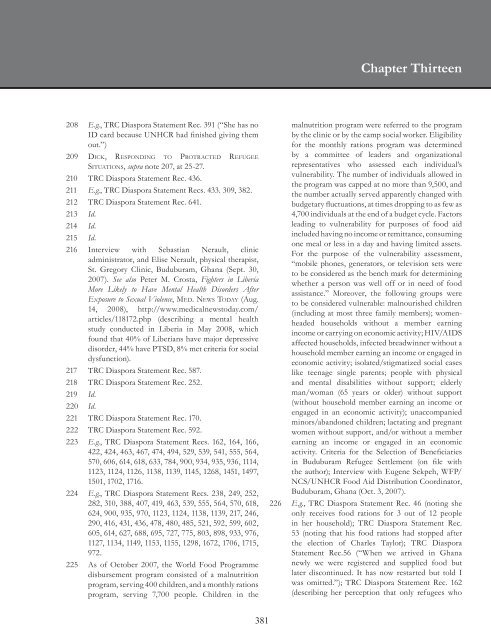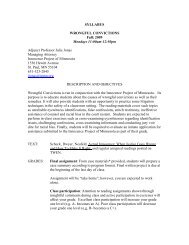A House with Two Rooms - The Advocates for Human Rights
A House with Two Rooms - The Advocates for Human Rights
A House with Two Rooms - The Advocates for Human Rights
You also want an ePaper? Increase the reach of your titles
YUMPU automatically turns print PDFs into web optimized ePapers that Google loves.
208 E.g., TRC Diaspora Statement Rec. 391 (“She has no<br />
ID card because UNHCR had finished giving them<br />
out.”)<br />
209 diCk, resPonding to ProtrACted refugee<br />
210<br />
situAtions, supra note 207, at 25-27.<br />
TRC Diaspora Statement Rec. 436.<br />
211 E.g., TRC Diaspora Statement Recs. 433. 309, 382.<br />
212 TRC Diaspora Statement Rec. 641.<br />
213 Id.<br />
214 Id.<br />
215 Id.<br />
216 Interview <strong>with</strong> Sebastian Nerault, clinic<br />
administrator, and Elise Nerault, physical therapist,<br />
St. Gregory Clinic, Buduburam, Ghana (Sept. 30,<br />
2007). See also Peter M. Crosta, Fighters in Liberia<br />
More Likely to Have Mental Health Disorders After<br />
Exposure to Sexual Violence, med. news todAy (Aug.<br />
14, 2008), http://www.medicalnewstoday.com/<br />
217<br />
articles/118172.php (describing a mental health<br />
study conducted in Liberia in May 2008, which<br />
found that 40% of Liberians have major depressive<br />
disorder, 44% have PTSD, 8% met criteria <strong>for</strong> social<br />
dysfunction).<br />
TRC Diaspora Statement Rec. 587.<br />
218 TRC Diaspora Statement Rec. 252.<br />
219 Id.<br />
220 Id.<br />
221 TRC Diaspora Statement Rec. 170.<br />
222 TRC Diaspora Statement Rec. 592.<br />
223 E.g., TRC Diaspora Statement Recs. 162, 164, 166,<br />
422, 424, 463, 467, 474, 494, 529, 539, 541, 555, 564,<br />
570, 606, 614, 618, 633, 784, 900, 934, 935, 936, 1114,<br />
1123, 1124, 1126, 1138, 1139, 1145, 1268, 1451, 1497,<br />
1501, 1702, 1716.<br />
224 E.g., TRC Diaspora Statement Recs. 238, 249, 252,<br />
282, 310, 388, 407, 419, 463, 539, 555, 564, 570, 618,<br />
624, 900, 935, 970, 1123, 1124, 1138, 1139, 217, 246,<br />
290, 416, 431, 436, 478, 480, 485, 521, 592, 599, 602,<br />
605, 614, 627, 688, 695, 727, 775, 803, 898, 933, 976,<br />
1127, 1134, 1149, 1153, 1155, 1298, 1672, 1706, 1715,<br />
972.<br />
225 As of October 2007, the World Food Programme<br />
disbursement program consisted of a malnutrition<br />
program, serving 400 children, and a monthly rations<br />
program, serving 7,700 people. Children in the<br />
381<br />
Chapter Thirteen<br />
malnutrition program were referred to the program<br />
by the clinic or by the camp social worker. Eligibility<br />
<strong>for</strong> the monthly rations program was determined<br />
by a committee of leaders and organizational<br />
representatives who assessed each individual’s<br />
vulnerability. <strong>The</strong> number of individuals allowed in<br />
the program was capped at no more than 9,500, and<br />
the number actually served apparently changed <strong>with</strong><br />
budgetary fluctuations, at times dropping to as few as<br />
4,700 individuals at the end of a budget cycle. Factors<br />
leading to vulnerability <strong>for</strong> purposes of food aid<br />
included having no income or remittance, consuming<br />
one meal or less in a day and having limited assets.<br />
For the purpose of the vulnerability assessment,<br />
“mobile phones, generators, or television sets were<br />
to be considered as the bench mark <strong>for</strong> determining<br />
whether a person was well off or in need of food<br />
assistance.” Moreover, the following groups were<br />
to be considered vulnerable: malnourished children<br />
(including at most three family members); womenheaded<br />
households <strong>with</strong>out a member earning<br />
income or carrying on economic activity; HIV/AIDS<br />
affected households, infected breadwinner <strong>with</strong>out a<br />
household member earning an income or engaged in<br />
economic activity; isolated/stigmatized social cases<br />
like teenage single parents; people <strong>with</strong> physical<br />
and mental disabilities <strong>with</strong>out support; elderly<br />
man/woman (65 years or older) <strong>with</strong>out support<br />
(<strong>with</strong>out household member earning an income or<br />
engaged in an economic activity); unaccompanied<br />
minors/abandoned children; lactating and pregnant<br />
women <strong>with</strong>out support, and/or <strong>with</strong>out a member<br />
earning an income or engaged in an economic<br />
activity. Criteria <strong>for</strong> the Selection of Beneficiaries<br />
in Buduburam Refugee Settlement (on file <strong>with</strong><br />
the author); Interview <strong>with</strong> Eugene Sekpeh, WFP/<br />
NCS/UNHCR Food Aid Distribution Coordinator,<br />
Buduburam, Ghana (Oct. 3, 2007).<br />
226 E.g., TRC Diaspora Statement Rec. 46 (noting she<br />
only receives food rations <strong>for</strong> 3 out of 12 people<br />
in her household); TRC Diaspora Statement Rec.<br />
53 (noting that his food rations had stopped after<br />
the election of Charles Taylor); TRC Diaspora<br />
Statement Rec.56 (“When we arrived in Ghana<br />
newly we were registered and supplied food but<br />
later discontinued. It has now restarted but told I<br />
was omitted.”); TRC Diaspora Statement Rec. 162<br />
(describing her perception that only refugees who
















